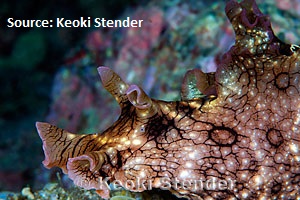
References
Bezzera L. E. A., A. F. U. Carvalho, L. A. Barreira, V. L. R. Nogueira, J. R. F. Silva, I. M. Vasconcelos and V. M. M. Melo. 2004. The relationship between seaweed diet and purple ink production in Aplysia dactylomela Rang, 1828 (Gastropoda: Opisthobranchia) from northeastern Brazil. Journal of Shellfish Reasearch 23: 581-584.
Borror, D.J. 1960. Dictonary of Word Roots and Combining Forms. Mayfield Publishing Company, Mountain View, California, USA.
Carefoot, T. H. 1970. A comparison of
absorption and utilization of food energy in two species of tropical
Aplysia. J. Exp. Mar. Biol. Ecol. 5: 47-62.
Carefoot, T. H. 1989. A comparison of time/energy budgeting in two species of tropical sea hares Aplysia. J. Exp. Mar. Biol. Ecol. 131: 261-282.
Carefoot, T. H., Pennings, S. C. and Danko, J. P. 1999. A test of novel function(s) for the ink of sea hares. Journal of Experimental Marine Biology and Ecology 237: 185-197.
Cummins, S.F., P. Nuurai, G.T. Nagle, and B.M.
Degnan. 2010. Conservation of the egg-laying hormone neuropeptide
and attractin pheromone in the spotted sea hare, Aplysia
dactylomela. Peptides 31: 394-
401.
DiMatteo, T. 1982. The ink of Aplysia dactylomela (Rang, 1828) (Gastropoda: Opisthobranchia) and its role as a defensive mechanism. Journal of Experimental Marine Biology and Ecology 57: 169-180.
Dionísio G., R. Rosa, M. C. Leal, S. Cruz, C. Brandão, G. Calado, J. Serôdio and R. Calado. 2013. Beauties and beasts: a portrait of sea slugs aquaculture. Aquaculture 408-409: 1-14.
Emore, M. 2002. Aplysia dactylomela. Animal
Diversity Web. <URL:
http://animaldiversity.ummz.umich.edu/accounts/Aplysia_dactylomela/>.
Accessed 7 April 2014.
Encyclopædia Britannica Online 2014. <URL: http://www.britannica.com/EBchecked/topic/226777/gastropod/35729/Classification?anchor=ref413245>. Accessed 15 April 2014.
Encyclopædia Britannica Online 2014. <URL: http://www.britannica.com/EBchecked/topic/388398/mollusk>. Accessed 15 April 2014.
Encyclopedia of Life 2008. <URL: http://eol.org/pages/451985/details>. Accessed 12 March 2014.
Klussmann-Klob, A. 2004. Phylogeny of the Aplysiidae (Gastropoda, Opisthobranchia) with new aspects of the evolution of seahares. Zoologica Scripta 33: 439–462.
Lederhendler, I. I. and E. Tobach. 1977.
Reproductive roles in the simultaneous hermaphrodite Aplysia
dactylomela. Nature 270: 238-239.
Marine Invertebrates of Bermuda (Aplysia dactylomela) 2004-2008. <URL: http://www.thecephalopodpage.org/MarineInvertebrateZoology/Aplysiadactylomela.html> Accessed 9 April 2014.
Medina, M., T. M. Collins, and P.J. Walsh.
2000. mtDNA ribosomal gene phylogeny of sea hares in the genus
Aplysia (Gastropoda,
Opisthobranchia, Anaspidea): implications for comparative
neurobiology. Systematic Biology 50: 676–688.
Melo, V. M. M., A. M. Fonseca, I. M. Vasconcelos, and A.F.F.U. Carvalho. 1998. Toxic, antimicrobial and hemagglutinating activities of the purple fluid of the sea hare Aplysia dactylomela Rang, 1828. Brazilian Journal of Medical and Biological Research 31: 785-791.
Sea Slug Forum 2000. <URL: http://www.seaslugforum.net/general.htm#sea_hares_(28including_aplysiomorpha,_anaspidea_and_aplysia)29>. Accessed 10 April 2014.
Sterrer, W. 1986. Marine Fauna and Flora of
Bermuda. A Wiley-Interscience Publication, New York, USA.
University of California Museum of Paleontology
2014. <http://www.ucmp.berkeley.edu/exhibits/biomes/marine.php>.
Accessed 12 March 2014.
Valdés, A., J. Alexander, F. Crocetta, M.B.
Yokes, S. Giacobbe, D. Poursanidis, A. Zenetos, J.L. Cerera, M.
Caballer, B.S. Galil, and P. J. Schembri. 2013. The origin and
dispersal pathway of the spotted sea hare Aplysia dactylomela
(molluska: opisthobranchia) in the Mediterranean Sea. Aquatic
Invasions 8: 427-436.
Aside from giving credit where credit is due, we would really like to thank all of the people who have made our website possible, whether by researching the species or by allowing us to use their images on our site.
View a collection of A. dactylomela images!
Questions about anything related to our site? Contact the Authors!
